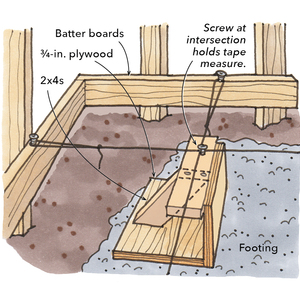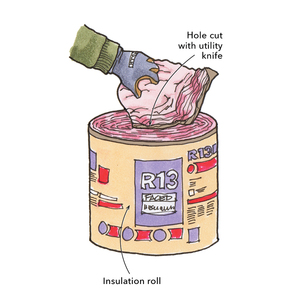Salt Water Flood Damage – Electrical Wiring
A relative’s home was flooded during Hurricane Sandy. The surge of water from the Great South Bay pushed the salt water level inside his home to a point just above the electrical outlets along the bottom of the walls of the first floor. The junction boxes in the crawl space under the first floor went under.
The main panel was well above the level of the water and he turned off the main breaker prior to the water level rising in the home. The home wiring is a mixture of BX and Romex.
Is there advice available as what electrical work must be done? The walls are stripped of insulation and sheetrock 4′ above floor level. I did not see any references to this situation in the NEC.
Should the junction boxes be replaced? Should the wire that has been under water be replaced? Any info or advice is greatly appreciated.
TIA



















Replies
From NAHB:
Do electrical switches, connections, receptacles, and wiring need to be replaced after flooding?
Question:
Do electrical switches, connections, receptacles, and wiring need to be replaced after flooding?
Answer:
In the majority of cases, wiring will not need to be removed and replaced after a flood. However, before making that determination, a thorough inspection by a qualified electrician may be required. First, stand on a dry spot and use a dry wood stick to disconnect the main electrical switch and all circuits at the panel box. If there is no main switch, turn off all circuit breakers or remove all fuses. Unplug all appliances that have been flooded. As soon as possible, remove all standing water from the structure, and dry out the interior as much as possible. Also, remove interior wallboard 12 inches above the maximum flood water height, remove any water-soaked insulation, and dry out wall cavities to preclude any water in the walls from continuing to soak into wiring and receptacles.
Then, have a qualified electrician do the following:
•Remove cover plates from all electrical outlets, receptacles, wall switches, and breaker or fuse boxes to inspect wiring and terminal connections.
•If the main box got wet, clean and check it.
•Check switches and outlets and their boxes for mud and dirt, which can cause a short or overheating.
•If there is a lot of mud, dirt, or salt water corrosion in switches or outlets, replace them. Look for broken electrical fixtures or exposed wiring.
•Replace all dimmers and electronic implements such as ground-fault circuit interrupters (GFCI), and arc-fault circuit interrupters (AFCI). Smoke detectors and thermostats that were immersed should also be replaced.
•Check the condition of wires that go to each switch and outlet. Replace any fabric-covered wire. Any aluminum wiring that has been flooded by salt water should be replaced.
•Have a qualified service technician inspect water heaters, furnaces, heat pumps, air handlers, water softeners, and all appliances and HVAC equipment. In many cases all such items should be replaced.
•Flush out boxes with clean water or air pressure; dry out and spray with cleaner/lubricant.
•Check continuity and grounding of all circuits, and check for electrical shorts. Check to ensure that all terminal connections are tight.
•Turn on each circuit, replace each fuse one at a time, and test each circuit. Make sure all ground-fault circuit interrupters (GFCI) and arc fault circuit interrupters (AFCI) are functioning.
•Test the operation of all smoke detectors and of the heating ventilation and air conditioning (HVAC) systems.
Here is another one - notice the section about water getting past the outer jacket of romex:
In accordance with Underwriters Laboratories (UL), Southwire,
The National Electrical Code NFPA 72, and National Electrical Manufactures Association (NEMA), the following direction regarding flood affected electrical wiring and equipment is provided.
Metal jacketed and cloth type “Romex” wiring within homes that have incurred flood waters exceeding the height of interior electrical wiring must be replaced to ensure proper wiring characteristics and to avoid future electrical problems as a result of saltwater.
Newer Romex (plastic outer jacket) NM-B wiring within homes that have incurred flood waters exceeding the height of interior electrical wiring where water has penetrated in to the “Outer Jacket” of the Romex wire must be replaced to ensure proper wiring characteristics and to avoid future electrical problems as a result of saltwater.
Large electric cable which supplies other electric panels in your home (other service cable SER / SEU) must also be replaced if submerged or water has entered through a splice point.
Other items that must be replaced or inspected as a result of submersion:
Receptacles
Metal boxes
splice boxes
Light fixtures (check your crawl spaces and lower floors)
Electric panels and utility meter sockets
Service cable (SER / SEU) follow same guideline for Romex NM-B.
Electronics such as Security Panels, Home Entertainment equipment, Thermostats.
Also consider other appliances such as dishwasher, garbage disposal, washer, dryer, refrigerator, freezer, heating and air condition equipment.
If you are unsure of the wiring in your home, contact a licensed electrical contractor.
If you electric service or meter has been affected by flood water keep your “Main Disconnect” in the “OFF” position and all other “Circuit Breakers” in the “OFF” position.
Thank you,
Don Clare
Borough of Monmouth Beach
Construciton Official / Flood Plain Administrator / Electric Subcode
732-229-2204 ext 112
[email protected]
Salt Water Flood Damage
Thank you for your help.
I have been rebuilding my house with a potential foot or two of water on the floor. All of my electric comes down from the top and it is THWN in smurf. I may be replacing some devices but the wire will be OK. I also used plastic boxes. With metal boxes, if they didn't work some oil or WD40 into those device screw threads the day the water dropped, they are rusted in place.
In the homes that were flooded in Rushford MN several years back, the inspector required all wire that had been under water to be replaced. And this was fresh, relatively clean water.
I certainly would not reuse any switches or receptacles that have been exposed to salt water. Switches and receptacles are cheap.
As to wiring, I remember pulling out a bunch of wire in Rushford, and was rather amazed at how much water came out of the plastic-sheathed romex, even when you cut a piece in the middle, 10-20 feet from an end. I would maybe trust wiring that ran down to an outlet from above, but I wouldn't trust wire that ran up from below.
One problem a lot of people may bump up against is the FEMA 50% rule. If you have to spend more than 50% of the appraised value of the building to fix it, they make you tear it down.
It was my impressioin that that FEMA rule only applies to flood plains, and I don't think most of the damaged areas from Sandy are in a flood plain.
I bet you see some new flood maps after this storm.
Some, but there would be a lot of push-back if there were major changes.
There may be some push back but with the evidence of the high water marks on the houses I bet FEMA wins.
It is ridiculous that anyone living less than 11 feet above sea level anywhere near the coast thinks they are not in a flood zone and everyone on a barrier island or right on the coast is in more trouble than that.
The Ny/NJ coast has been dodging bullets for 100 years and decided they were bullet proof. New Orleans has the same problem.
Homes along the Gulf Coast and on the Carolina barrier islands were rebuilt again and again with federal insurance. Slowly the feds have chiseled away at the issue, but it's taken decades. And the economic impact of effectively destroying half the homes flooded by Sandy would be more expensive than continuing to insure them.
Now when you rebuild or repair from a storm in Florida you have to build to new code and we don't have near as many houses that are total losses because the damage is not that bad. The FEMA elevation rule is strictly enforced here, unlike NOLA.
After Charley and Wilma, newer houses were not really hurt at all. Tree damage was still the biggest issue but people are getting smarter about trees near the house and FPL is very aggressive about trees in the right of way. They just get whacked.
rebuilding after flood
I've tried to research wet flood proofing to minimize damage the next time we get a Sandy-type flood. Most info came from post-Katrina blogs and websites. Most useful advice seems to require 7 aspects to rebuilding a water damaged home where the bottom floor is finished, but not insurable because the first "real" floor is above on pilings.
1. Allow everything to dry out after removing 4 feet of drywall and insulation
2. Move all electrical to 4 feet above floor replacing recepticles and romex.
3. Paint back of sheathing and studs with waterproofing
4. Replace all mechanicals and put on 4 foot high pressure-treated platforms
5. Replace fiberglass insulation with 2" closed cell foam tightly fitted between studs to 4 foot height
6. Replace dry wall with Dragonboard or similar waterproof material, but do not nail to studs. Rather, use large baseboard (plastic) and chair rail trim to hold in place.
7. For the floor, sealing the concrete and ceramic tiling is recommended.
Then, when the next flood occurs, remove chair rail, Dragonboard and foam so wood can dry. Replace when dry and you are done.
Has anyone used this system? Comments would be greatly appreciated.
Instead of Romex, use UF. The difference in price is minimal and it is wet location cable. It will survive being under water.
But the cable ends must never be under water.
Why not? The UF will not wick up water like Romex and if you cut the exposed end and strip back 1/8" the copper will be clean and shiny. We ran into a similar situation with the thousands of Chinese drywall houses we had here. The gas is certainly as invasive as water.
Salt Water Damage
I know it is a little late for an answer but I came across your post looking for some other info myself, I am a flood adjuster and handle many claims in that area which I was there for 4 months and I am still not finished. I am now home closing the files that I had, but to answer your question in regards to coverage per NFIP. As long as the wire, item or property was directly affected from the flood water or altered from its normal condition that it would be coverage, as far as code county, local or state that is one item that the flood program does not cover and is left to the insured. So if crawlspace wiring was damaged by the salt flood surge and now homeowner has to bring has to bring the electric up to code it would not be covered just the wire or other items that were directly affected.